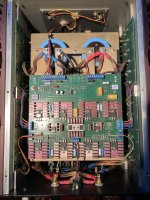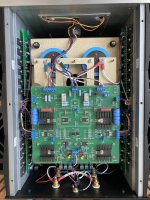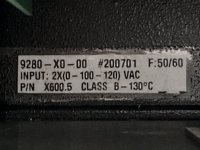I'm very familiar with Threshold products (still have a FET 11g (German FET 10HL e series) and a Stasis 3 on Infinity's Kappa 9A's (Yes the LED's go all the way up when thundering along when my wife likes to dance to a beat, no kiddin'). In the past I've had a S/300 Series II, two S/500's, S1000 series II and SA1/'s optical bias.
The S/1000 was a bridged S/500 and the SA/1 a massive parallel S/500 throttled back to a railvoltage that allowed 160 Watts Class A at 8 Ohms.
The Pass X1000 is a bridged amp also like the X600 and X600.5 which are bridged X350/350.5s.
The XA160 is a single ended massive parallel X350 (probably the best sounding of the four?) and the X160.5 is a pushpull massive parallel X350.
Please correct me when my assumptions are wrong.
I've read a Stereophile review of the XA160 (1 nov 2003, https://www.stereophile.com/solidpoweramps/1103pass/index.html) and although very favorable soundwise the measurements weren't that great especially in the current department. If you have a hornloudspeaker there's no problem, but anything with a low efficiency combined with a tough load makes these amps unhappy I think. I have such a speaker an Infinity QLS.
In that case would a X600.5 my best choice and what is exactly the difference between the X600 I operate now and the X600.5?
Thanks
The S/1000 was a bridged S/500 and the SA/1 a massive parallel S/500 throttled back to a railvoltage that allowed 160 Watts Class A at 8 Ohms.
The Pass X1000 is a bridged amp also like the X600 and X600.5 which are bridged X350/350.5s.
The XA160 is a single ended massive parallel X350 (probably the best sounding of the four?) and the X160.5 is a pushpull massive parallel X350.
Please correct me when my assumptions are wrong.
I've read a Stereophile review of the XA160 (1 nov 2003, https://www.stereophile.com/solidpoweramps/1103pass/index.html) and although very favorable soundwise the measurements weren't that great especially in the current department. If you have a hornloudspeaker there's no problem, but anything with a low efficiency combined with a tough load makes these amps unhappy I think. I have such a speaker an Infinity QLS.
In that case would a X600.5 my best choice and what is exactly the difference between the X600 I operate now and the X600.5?
Thanks
OS in X600 and X600.5 are basically the same, so you can expect same drive capability
can't say in details is there difference in PSU capability, though I think younger one is having that beefed too
main difference being in FE, older one being straight all MOS jobbie, while later one having full JFet FE, so called UGS
you can expect more details with newer one
will you like it or not, only you can tell
oh yes, there is also some care taken of having slightly more SE of sound character on lower power, in 600.5
regarding some topology assumptions you made in first part of post, I believe there are some mistakes, but I have no time now to be picky
can't say in details is there difference in PSU capability, though I think younger one is having that beefed too
main difference being in FE, older one being straight all MOS jobbie, while later one having full JFet FE, so called UGS
you can expect more details with newer one
will you like it or not, only you can tell
oh yes, there is also some care taken of having slightly more SE of sound character on lower power, in 600.5
regarding some topology assumptions you made in first part of post, I believe there are some mistakes, but I have no time now to be picky
Robert,
IIRC, that Stereophile review was for a pair that had not been adjusted per design and hence did not meet its output spec. It was notable for me because it was the only time I saw PL responding to a review.
Also, I believe the X350 has push-pull output stages combined with the SUSY feedback/error correction, while the XA160 is a combination of the SUSY with Aleph.
IIRC, that Stereophile review was for a pair that had not been adjusted per design and hence did not meet its output spec. It was notable for me because it was the only time I saw PL responding to a review.
Also, I believe the X350 has push-pull output stages combined with the SUSY feedback/error correction, while the XA160 is a combination of the SUSY with Aleph.
Okay clear. So apart from the DIY amps, the last SE amps from Pass were the XA160 and XA200 that when reducing the impedance of the load will not convey any additional power as a push pull design would?No the XS technology found it’s way into the other amps. A portion of the bias is single ended.
You could look at it that way although even the Alephs could put a bit more into the load.
Current product has a special output stage that imparts some single ended and push pull with a bit of feedback.
Current product has a special output stage that imparts some single ended and push pull with a bit of feedback.
Thank you for your reply. It's clear to my now.You could look at it that way although even the Alephs could put a bit more into the load.
Current product has a special output stage that imparts some single ended and push pull with a bit of feedback.
Just substituted my pair of Pass X600 for a pair of X600.5 which paid of in terms of a better amplifier in almost all parameters.
It's more delicate, more refined, more precise has a very noisefree background only the slam in the lower register seems a bit shy compared to the X600 but still better in detail.
This is the frontend of my X600:

This is the frontend of my X600.5 (somewhat smaller PCB)

There are 4 jumpers (two yellow with marking 'DC' alongside and two blue ones with marking 'Low') and one pot (P2) with 'Differential'.
Although I can deduct that with the Yellow jumpers the DC setting overrides a input filmcap? And the Blue jumpers in the Low setting is to lower the gain?
Differential has something todo with the amount of cancelling between the X channels??
The other 4 pots are DC and Bias of which I have some notion of and I wish I would know the values of the bias and the testpoints I could check their values.
This is a adhesive which I found glued on the bottom of the amp:

Which states that the X600.5 is a thoroughbred Class B amplifier and precisely that explains why it sounds so wonderful.
It's more delicate, more refined, more precise has a very noisefree background only the slam in the lower register seems a bit shy compared to the X600 but still better in detail.
This is the frontend of my X600:

This is the frontend of my X600.5 (somewhat smaller PCB)

There are 4 jumpers (two yellow with marking 'DC' alongside and two blue ones with marking 'Low') and one pot (P2) with 'Differential'.
Although I can deduct that with the Yellow jumpers the DC setting overrides a input filmcap? And the Blue jumpers in the Low setting is to lower the gain?
Differential has something todo with the amount of cancelling between the X channels??
The other 4 pots are DC and Bias of which I have some notion of and I wish I would know the values of the bias and the testpoints I could check their values.
This is a adhesive which I found glued on the bottom of the amp:

Which states that the X600.5 is a thoroughbred Class B amplifier and precisely that explains why it sounds so wonderful.
Yes I know. Just found it humorous: "X600.5 CLASS B" Need a volumesetting that disables me to hear my own voice to get that meter moving, get it out of Class A into B.That's the transformer label...
Is it a a custom made Plitron the 9280? And do you know the VA rating?
We would have to talk to the Boyz at the factory, as they have the production documents, but Plitron has been one of the suppliers in the past.
Okay I will try to get that information from the Boyz at the factory as the intel about those jumpers J2, 3, 4 & 5.We would have to talk to the Boyz at the factory, as they have the production documents, but Plitron has been one of the suppliers in the past.
closing jumpers J2 and J3 (pin 2 to 3, reading ~7K in between) increases gain for 4-5db (db figure is ZM's eyeballing)
from Book of Yore:
"P2 adjusts the differential DC offset of the amplifier (the DC voltage between the two output
terminals) and P5 adjusts the absolute DC offset (the DC voltage from the outputs to
ground).
P1 is used to adjust the front panel meter.
Jumpers J4 and J5 allowing bypassing the input capacitors. The amplifiers are shipped
with no jumper, and bypassing the capacitors is not recommended for consumer
application"
now, two more trimpots on pcb are labeled, so you'll know their role
again from Book of Yore:
"The differential DC offset between the two outputs will be less than 50 mV.
The absolute DC offset between each output and ground will be less than 500 mV.
The bias voltage of each output stage (as measured between the wire loops on either
side of the terminal blocks on the motherboard going to the output stage) is 60 mV (+/-
10%)."
all of this not to show that I have snippets of Book of Yore, but to relieve Pa of some digging, leaving him more time to play with Doggies
from Book of Yore:
"P2 adjusts the differential DC offset of the amplifier (the DC voltage between the two output
terminals) and P5 adjusts the absolute DC offset (the DC voltage from the outputs to
ground).
P1 is used to adjust the front panel meter.
Jumpers J4 and J5 allowing bypassing the input capacitors. The amplifiers are shipped
with no jumper, and bypassing the capacitors is not recommended for consumer
application"
now, two more trimpots on pcb are labeled, so you'll know their role
again from Book of Yore:
"The differential DC offset between the two outputs will be less than 50 mV.
The absolute DC offset between each output and ground will be less than 500 mV.
The bias voltage of each output stage (as measured between the wire loops on either
side of the terminal blocks on the motherboard going to the output stage) is 60 mV (+/-
10%)."
all of this not to show that I have snippets of Book of Yore, but to relieve Pa of some digging, leaving him more time to play with Doggies
Are you sure about this 500 mV or .5V DC offset for absolute DC?The absolute DC offset between each output and ground will be less than 500 mV.
absolute offset is offset between both outputs and GND
differential offset is offset which speaker is seeing, that one being smaller
sure, yes
differential offset is offset which speaker is seeing, that one being smaller
sure, yes
Yes I gathered that, but the value of 500mV seemed a bit high but you have the specs in front of you so you must be right.absolute offset is offset between both outputs and GND
differential offset is offset which speaker is seeing, that one being smaller
sure, yes
Absolute offset is in my case +/-140mV for bot units and differential offset is around 1 mV.
Bias is 40mV on both channels and units but this is a 240V unit (probably UK) and I'm in continental Europe 230 Volts and with both units on at night 223 Volts. That doesn't explain the 1/3 decrease in value from 60 to 40mV so I think it's a bit too low.
They "only" take 300 Watts each from the wall and in the manual it says it should be around 550 Watts.
With the exponential increasing energy prices for natural gaz and electricity (sometimes they quadruple) thanks to EU policy against Russia and their Green Deal, I'm not to sad about this although I've seen the distortion graphs of NP regarding increasing the applied bias in his technical article named 'Leaving Class A':
NP: "In Fig 3 we see the distortion of an output stage operated without feedback driving 8 ohms from 0.10 watts up to 20 watts. The top curve with the highest distortion has a bias of 0.016 amps. The next lower is 0.08A, followed by 0.16A, 0.32A, 0.64A, 1.28A, and the lowest distortion curve at 2.56 amps. What we see clearly is that higher bias lowers the distortion at all power levels, and that the distortion is inversely proportional to the bias current."
I've no idea on which curve I'm on now with the 40mV bias setting but they still sound great to my ear....
well, you have them and now you're complaining that offset is lower than max. allowed by factory standards .......
O Tempora, O Mores!

you're good ....... increase Iq or leave it as is .......... now you know procedure, so everything is easy
for general guidance, nomenclature certainly different but approach is same - see here : https://www.zenmod.in.rs/pass-labs-x150-5-checkingadjusting-offsets-iq-and-gain/
did I said that X600.5 is for Weaklingsessss?

O Tempora, O Mores!

you're good ....... increase Iq or leave it as is .......... now you know procedure, so everything is easy
for general guidance, nomenclature certainly different but approach is same - see here : https://www.zenmod.in.rs/pass-labs-x150-5-checkingadjusting-offsets-iq-and-gain/
did I said that X600.5 is for Weaklingsessss?

- Home
- Amplifiers
- Pass Labs
- Pass X600, 600.5, 160 & 160.5